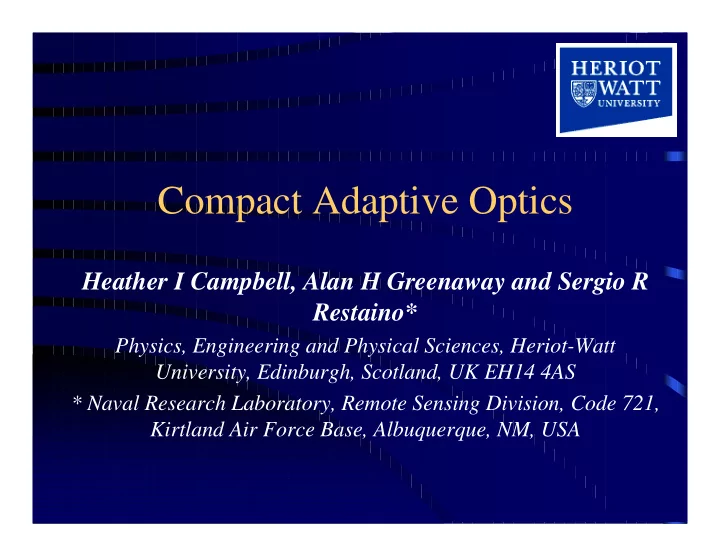

Compact Adaptive Optics Heather I Campbell, Alan H Greenaway and Sergio R Restaino* Physics, Engineering and Physical Sciences, Heriot-Watt University, Edinburgh, Scotland, UK EH14 4AS * Naval Research Laboratory, Remote Sensing Division, Code 721, Kirtland Air Force Base, Albuquerque, NM, USA
Acknowledgements •Much of the work presented today was funded by the US Air Force Office of Scientific Research through the European Office of Aerospace Research and Development (EOARD), based in London OMAM Collaborators: OMAM Funding Institutions: 24/06/03 CLEO Munich 2003
Introduction • Compact Adaptive Optics? Format for this talk: – Brief look at existing phase diversity method. – Motivation for a more general method. – Generalisation – Progress to date – Conclusions and suggestions for future work 24/06/03 CLEO Munich 2003
Phase Diverse Wavefront Sensing • Solution of ITE gives wavefront − ∂ I I I � Plane 1 Plane 2 − ∂ z z z 1 2 ′ ∂ I r ( ) � ′ ′ Ψ =− ( ) r k dr G r r ( , ) ∂ z R • DoE used to image Planes 1 & 2 24/06/03 CLEO Munich 2003
Diffractive Optics •Images of different object layers recorded on the same focal plane Blanchard, P.M., et al., Phase-diversity wave-front sensing with a distorted diffraction grating. Applied Optics, 2000. 39 (35): p. 6649-6655. •The plane separation and image locations are determined by the properties of the grating 24/06/03 CLEO Munich 2003
Examples of Data •Some examples of the data seen at the focal plane. •Easy to see the aberrations present in the data just by eye. •Defocus •Astigmatism •Coma •Trefoil •Spherical Aberration Blanchard, P.M., et al., Phase-diversity wave-front sensing with a distorted diffraction grating. Applied Optics, 2000. 39 (35): p. 6649-6655. 24/06/03 CLEO Munich 2003
Limitations • The current Greens’ function solution carries implicit assumptions which limit the wavefront sensor: – It is assumed that the input illumination is uniform (i.e no scintillated wavefronts). – It is assumed that the wavefront and its slope are continuous. – Dynamic range limitations 24/06/03 CLEO Munich 2003
Generalisation • Move away from the physical picture of the 2 defocus method. • Current method: Convolution with the defocus kernel. • What about other aberration kernels? • Limitations? 24/06/03 CLEO Munich 2003
Generalisation • Advantages: polishing applications, segmented optics, imaging of silicon circuitry… Some obvious questions: – What, if anything, is special about Defocus? – What generic properties must a filter function possess? – Can this be optimised so that particular filter functions may be used for particular applications? 24/06/03 CLEO Munich 2003
Sufficient Conditions • Necessary and Sufficient conditions are needed to characterise suitable functions for use in a null sensor. • Sufficient condition: the difference between two aberrated images is null if the input wavefront has an Hermitian transform, and non null for non-plane wavefronts. ℑ If f(r) is real then {f(r)} is Hermitian * ξ ℑ ξ ξ i.e. F( )= {f(r)} then F( )=F (- ) 24/06/03 CLEO Munich 2003
Necessary Conditions • Necessary condition:The filter function must be complex. Mixed symmetries of the real and imaginary parts must not be used. ξ ξ ξ Filter function P( )= R( )+i.I( ) ξ ≠ ξ ≠ 1) I( ) 0 ; R( ) 0 ξ ξ ξ ξ 2) I( )=I(- ) and R( )=R(- ) [both even symmetry] ξ ξ ξ ξ or I( )=-I(- ) and R( )=-R(- ) [both odd symmetry] 24/06/03 CLEO Munich 2003
Implementation •SLMs provide modulation. •DoE combines phase diverse data and corrected image. •CMOS camera • A compact adaptive optics system 24/06/03 CLEO Munich 2003
Data Reduction • Error Reduction algorithms using FRFT’s and or FFT’s to provide a numerical solution to the data reduction • Work to continue on an analytic solution. • Full reconstruction is unnecessary when used as a null sensor for adaptive optics. • Processing speed/computer power is not an issue in this case. 24/06/03 CLEO Munich 2003
Further Work Optimisation: – Are there optimum filter functions for particular applications? • Practical tests: – Data reduction. – Manufacture and testing of customised gratings 24/06/03 CLEO Munich 2003
Conclusions • There is a need for a more generalised approach to phase diverse wavefront sensing to overcome the limitations of the current method. • Necessary and sufficient conditions for a null sensor have been obtained. • It has been shown that the construction of a compact adaptive optics system using a generalised method is possible. • Optimisation and experimental testing is to be conducted 24/06/03 CLEO Munich 2003
Recommend
More recommend